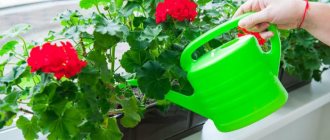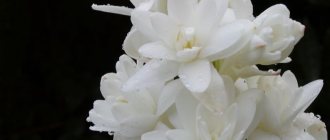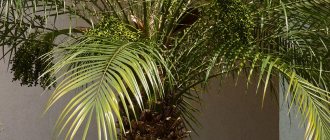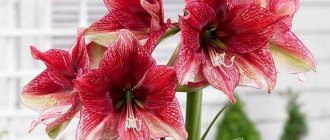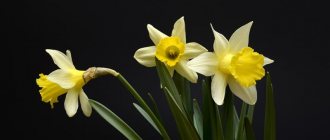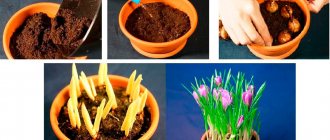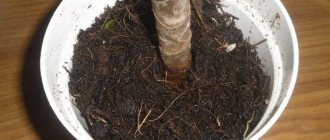It is difficult to find another indoor flower that can easily be called a real find for a gardener with any experience behind him. But dracaena is just such a plant.
Dracaena is indeed a frequent guest in most apartments, houses, offices, and public places. The reason for this spread is that it requires virtually no care. In fact, the plant only requires sufficient light and occasional watering.
At the same time, dracaena always remains an amazingly beautiful living decoration of most classical and modern interiors. And this plant’s advantages are added by the fact that about 20 of its species can be grown indoors, each of which will be unique, original and attractive in its own way.
Dracaena palm: types, benefits and harm, homeland, poisonous or not for humans and cats: description, photo
Dracaena Derema
Dracaena fringe
Dracaena Godsefa
Dracaena Reflexa
Dracaena Fragrant
Africa is considered the birthplace of the dracaena palm tree. It is in this place on the globe that you can find the largest number of representatives of this plant. Since the climate here is the most favorable for them, dracaenas growing in Africa, as a rule, are always very tall. Lower species are found in India, South America and the Canary Islands. Palm trees growing in these areas are less finicky, which is why they are most often sold in our country.
When purchasing dracaena, you should take into account that it is a low-toxic plant, the juice of which can harm the human digestive system. When ingested, it begins to irritate the mucous membranes of the stomach and intestines, and against this background a person may develop diarrhea, which will be accompanied by vomiting and nausea. And although you definitely won’t die from this, it will still be better if you take measures that will prevent dracaena juice from getting on the mucous membranes of the mouth.
Types of dracaena palm:
- Dracaena Derema (tall plant with characteristic white lines on the leaves)
- Dracaena marginata (has long leaves that are located at the very top of the tree trunk)
- Dracaena Godsepha (looks like a bush with large spotted leaves)
- Dracaena Reflexa (distinctive feature is the presence of a tree-like trunk and long curved leaves)
- Dracaena fragrant (adult plant blooms with beautiful white flowers)
Benefits of dracaena:
- Removes formaldehyde, ammonia and carbon from the air
- Ionizes the air around it
- Creates a favorable climate in the house
- Releases substances into the air that promote human health
Harm of dracaena:
- May cause an allergic reaction
- If ingested, it causes diarrhea
- Dust collected on leaves can become a haven for dust mites
Types of dracaena
There are at least 140 species of dracaenas known to exist in the wild. Some of them are full-fledged trees, reaching a height of 20 meters or more. Some are ordinary low-growing shrubs.
But only about 20-30 species of dracaenas are grown in indoor floriculture today. Some of them are practically no different from each other. Others have unique, original features. But in any case, this plant must be present in every home greenhouse, and these are not empty words.
Let's take a look at the most common and beautiful types of homemade dracaenas.
Capitate (D. Phrynoides)
Dracaena has an unusual leaf shape.
If its lower part, namely the trunk, can be called classic, then the leaf blades are oval, elongated, wide (up to 10 cm) and covered with noticeable light green spots.
This variety can be considered very unpretentious in care, but the plant is rarely found on sale.
Hooker (D. hookeriana, D. rumphii)
A very common type of dracaena. Why? Because it is extremely unpretentious and can go without water for a long time. Of course, in this case the plant will not look perfect, but in order to destroy the flower, you will have to get creative.
It is precisely because of its easy care that most gardeners must have Hooker's dracaena in their collection of indoor flowers.
The flower itself can be classified as a medium-sized plant. The maximum known height when grown indoors is 1.5 m. Dracaena of this species is close to the classic varieties: it has a thick woody stem, at the top of which long leaves (50-70 cm) extend, thus forming a crown.
In the summer, this dracaena can even be taken out into the open air for the entire season.
Deremenskaya (D. Deremensis)
A less common species of dracaenas, however, it also has its own distinctive qualities.
The young plant is initially completely covered with foliage, but as it grows, the lower tier of leaves falls off, leaving characteristic marks on the bark - a unique pattern.
Visually, the entire flower resembles the classic forms of dracaenas - at the bottom there is a trunk with hard bark, and at the top there is a leafy cap.
This species has wide leaves, reaching 6-8 cm in width.
Sometimes the central part of the leaf is painted a different color than the rest of the plate.
Derema dracaena can grow up to 2-3 meters in height, but this does not happen often.
ON A NOTE. This variety blooms extremely rarely, but if this happens, it is better to pick off the flowers in advance, as they have a sharp, unpleasant smell.
Dragon (D. Draco)
A variety of dracaenas with a special trunk appearance. In an adult plant it can be quite dense and thick.
Also, its surface is formed by bark, which is layered on top of each other with scales, which is why it resembles the mythical dragon skin.
In the upper part of the flower a dense cap of leaves grows, reaching up to 50-60 cm in length. Their structure is quite dense, so they do not bend downwards.
In nature, in its homeland, the Canary Islands, the Dragon dracaena can reach a height of 20 meters.
Indoor varieties - rarely grow more than 1 m.
The reddish resin juice of the plant is considered healing.
Fragrant (D. fragrans)
This type of dracaena is quite traditional and one might even say inconspicuous, if not for two excellent decorative qualities.
Firstly, fragrant dracaena exudes a rather noticeable aroma. Usually the flower smells most fragrant in the evening hours, after sunset.
But flowering of this species is difficult to achieve. This will require 12-14 hours of daylight for at least six months, which is a rare occurrence in most regions of Russia.
Secondly, the fragrant dracaena itself, even without flowering, looks quite decorative. It can grow indoors up to 6 meters (although most often no higher than 3 m). At the same time, even without special formation, its crown remains neat and stably thickened.
BE CAREFUL! Fragrant dracaena can be dangerous for allergy sufferers!
Golden lime (D. goldieana)
An excellent variety with decorative properties, which also does not require serious care.
Dracaena Lime Goldena differs from most types of classic dracaenas in that it looks very much like a mini palm tree. Its trunk is practically invisible to the eye, and the long and wide leaves visually grow as if straight from the ground.
However, there are other varieties of this variety. So, you can grow a flower that will stretch upward, and at the very top will bloom with an abundant bunch of leaves.
Bordered or Marginata (D. Marginata)
Perhaps this is the most common dracaena in indoor floriculture.
Its main competitive advantages: amazing unpretentiousness, strong immunity, a calm attitude towards the quality of the substrate in the pot, and a rather beautiful appearance.
As a rule, Dracaena Marginata grows to a small size, only occasionally exceeding 2 or even 3 meters.
The flower looks neat, gradually turning into a palm tree in shape.
The lower part is a wooden trunk, always with several branches rising upward.
The top is strewn with long leaves that grow upward and then bend downward under their own weight.
Some species of Marginata have monochromatic foliage. But there are varieties with leaves decorated with a red, burgundy or beige border.
Reflexed (D. Reflexa)
A rather rare specimen, primarily due to its whimsicality.
This dracaena is truly capricious, blooms extremely rarely, grows slowly, and, having reached adulthood, lives only 3-4 seasons, after which it dies.
But the decorative qualities of the species are difficult to overestimate. It got its name because of the original, sparse leaves that bend downwards (like curls).
An interesting color complements the picture: a white or yellow edging appears along the edges and at the tip of the long leaves.
Sanderiana or Dracaena bamboo (D. sanderiana)
Of course, dracaena bamboo has nothing to do with real bamboo, but the name stuck. Mainly because of its very bamboo-like trunk.
Some craftsmen manage to direct the growth of a plant in such a way that they create truly bizarre shapes.
The small shoots, which can most often be found on sale, are small columns, and at their top there is a small bunch of leaves.
When the flower grows, it acquires the original shape of a trunk and a profuse cap, decorated with not the longest (“only” up to 25 cm) erect leaves.
This type of dracaena is quite compact, does not grow more than 1 m. It fits very well into modern minimalist types of interiors.
Surculosa (D. surculosa)
A rare specimen of dracaena in nature (found exclusively in the African country of Sierra Leone), although it can be found in indoor floriculture more often than it might seem.
Surprisingly, growing this type of dracaena is even quite simple. In the south of Russia this is done, including on open ground.
The peculiarity of Dracaena Surculosa is that it grows directly from the ground without a trunk. Thus, the plant is like several shoots that immediately emerge from the ground, but have a common root.
High decorative properties are characteristic of the foliage of this species. It is unusual, it does not resemble elongated leaf blades, like most other dracaenas, but rather classic leaves, slightly pointed towards the edge.
They are painted in a highly original way - like leopard spots, numerous white specks of different sizes appear on a dark green background.
Sheepweed (D. umbraculifera)
Dracaena with very long leaves (up to 90 cm) and a classic woody trunk in the lower part.
When grown indoors, it grows up to one and a half meters.
The number of leaves in the cap is small, as they are very large and wide.
The leaf blades grow vertically upward, but then gradually droop downwards.
This dracaena is quite demanding to care for, as the leaves can dry out from the slightest temperature changes, drafts or lack of watering.
Why is the dracaena palm called dragon, dragon tree, tree of happiness, can it be kept at home?
Dracaena - the tree of happiness
The dracaena palm has several names, so if you are offered to buy a dragon tree or a tree of happiness, know that this is it. Why is she called that? The Latin word dracaena translated into Russian means dragon, so a large number of gardeners prefer to call this plant a dragon tree. As for another popular name (tree of happiness), it is associated with a very romantic legend. A young guy fell in love with a very beautiful girl and asked her to become his wife.
She agreed to the marriage, but her father categorically did not agree to give his beloved daughter to the poor young man. And in order for the wedding not to take place, he came up with a task that, as it seemed to him, the young man would never be able to complete. He stuck an ordinary dry stick into the ground and said that he would allow his daughter to marry only if she became a beautiful plant. Out of desperation, the young man began to water the stick every day, and on the fifth day it was covered with beautiful green leaves. As a result, the lovers got married, and dracaena became a talisman of their family happiness.
As for whether it is possible to keep dracaena at home, we can definitely say that this decorative flower should be in every home. The dracaena palm tree is considered a natural peacemaker that is capable of defusing the atmosphere in the house. For this reason, it is very often placed in living rooms or kitchens, thereby trying to prevent household members from quarreling among themselves. Astrologers, in general, believe that this plant can positively influence people and help them cope with fears and problems.
Why the dracaena palm blossomed and died: signs and superstitions
Dracaena palm: signs and superstitions
Dracaena is one of those plants with which many signs and superstitions are associated. For example, it is believed that this exotic plant must be in a house where there is an unmarried girl. Moreover, it should be in her bedroom, and she herself should take care of it. It is believed that if a girl does everything right and the flower feels good, then its positive energy will definitely attract her soulmate to her and this will happen exactly when the palm tree blooms.
If a married woman’s plant is covered with beautiful flowers, then by their number and size she will be able to judge the strength of her husband’s love. It is believed that a large number of large flowers indicates that a man has the strongest feelings for his chosen one. In addition, the lush flowering of a palm tree can promise a person unexpected success. Most often this is associated with an improvement in financial condition, success at work, or a big win in the lottery.
But if your dracaena died with proper care, then you need to prepare for trouble. If the flower dries slowly, this may indicate that all the money will flow out of your house for quite a long time. If the palm tree dies in literally 2-3 days, it indicates that a person close to you will soon die. Moreover, this will not necessarily be your blood relative, it could be a friend or just an acquaintance.
What kind of soil, soil, pot is needed for planting and replanting a dracaena palm tree?
Soil for the dracaena palm
I would like to say right away that although dracaena is an unpretentious plant, it is still better to plant it in special soil. This means that it is undesirable to take soil from the garden to plant it. As practice shows, such soil dries out very slowly, which leads to the roots of the plant beginning to rot. And don’t think that a drainage layer will help you correct the situation. The palm tree's root system is so well developed that some of the small roots are very close to the soil surface.
Therefore, no matter how hard you try to water it correctly, some part of the roots will always feel an excess of moisture. Therefore, if possible, buy in specialized stores soil repurposed for growing dracaena, or, at worst, universal soil, suitable for all indoor plants without exception. If you want to prepare the soil yourself, then take peat, humus, turf soil and sand in equal parts, and be sure to add perlite to them. The last component is required because it will help make the soil looser.
Now let's figure out which pot the dracaena should grow in. If you need to transplant the baby, then choose a small pot for this. If you plant it in a large container, it will grow a root system, but the upper part will remain small. Well, if you need to replant an adult dracaena palm tree, then buy a pot, the diameter of the upper part of which is literally 2 cm larger than the previous one.
How to replant dracaena
Make the first transplant 10–14 days after purchase. Store-bought plants are usually in peat, which is good for transportation, but not suitable for long-term cultivation.
Replant young dracaena every year. One that is more than 5-6 years old - every 2-3 years, depending on the growth rate. As soon as the root system becomes crowded, change the pot.
Try to carry out this procedure in spring or early summer.
Which pot to choose for dracaena
Choose a tall but not wide pot for the plant. This form corresponds to the characteristics of the root system.
In size - a centimeter or two larger than the previous one in width and height. If the soil is too large, it will quickly turn sour and the roots will begin to rot.
Which land to choose for dracaena
Use a special soil for palm trees or a mixture of all-purpose and baking powder in a ratio of 4: 1. Baking agents can be coconut chips, coarse sand or fine gravel.
Place a centimeter and a half of drainage, such as expanded clay, at the bottom.
How to transplant
If you are replanting for the first time after purchase, carefully clear the root system of soil and place it in a new soil mixture.
When planning a transplant, remove the dracaena along with the soil. Lightly shake off the lump and place it in a new pot with drainage and some soil at the bottom. Fill the voids along the walls and compact lightly.
Take proper care of the bulb

